Postgraduate Students I have co-/advised the following postgraduate students who have completed their PhDs at Durham: Kevin Pimbblet, Graham Smith, Mark Swinbank, Jim Geach, Julie Wardlow, Alice Danielson, James Simpson, Stuart Stach, Anne Klitsch, Ugne Dudzeviciute and Jack Birkin. I have also worked closely with Durham students including Stuart McAlpine, John Stott, as well as long-term visiting students at Durham: FangXia An, Hiddo Algera and Suzie Alaghband-Zadeh.
Jack Birkin (STFC, 2018-2022)

Jack worked on two projects as part of his thesis. The first of these was a survey of the molecular gas content in high-redshift dusty, star-forming galaxies which have been identified from their dust continuum emission using the Atacama Large Millimeter Array (ALMA). Jack investigated the cool gas content of ~60 of these galaxies using observations of the emission lines due to transitions of the CO molecule in the millimetre waveband (which trace the main gas constituent, H2, that fuels the star formation in these galaxies) from ALMA and the NOEMA array. He showed that the cool gas fraction of these galaxies increases at earlier times, potentially explaining the trends seen in the population, and that the predicted kinematic and baryonic properties of their present day descendants match those seen for local ellipticals. Jack's second project involved the KAOSS Large Programme using the KMOS near-infrared multi-IFU spectrograph on the VLT. He employed KMOS to study the redshifts and kinematics of the ionised gas in a sample of ~500 ALMA-identified dusty star-forming galaxies. The first results from this survey focused on the spatially resolved kinematics of a subset of ~40 galaxies, demonstrating that they are both more massive and more turbulent than ``typical'' star-forming galaxies at these redshifts.
Jack is currently a postdoc at Texas A&M.
Thesis Publications
``KAOSS: kinematics of dust-obscured star-forming galaxies at z~1.5-2.5'', Birkin, et al., (2022). (Link).
``An ALMA/NOEMA survey of the molecular gas properties of high-redshift star-forming galaxies'', Birkin, et al., (2021). (Link).
Ugne Dudzeviciute (STFC, 2017-2021)

Ugne's thesis project comprised energy-balance modelling of the largest sample of ALMA-identified star-forming galaxies, ~700 galaxies from the ALMA/SCUBA-2 UDS (AS2UDS) survey, which was also part of Stuart's thesis. Ugne applied the MAGPHYS code to the multiband photometry for this sample to derive redshift estimates and physical properties (masses, far-infrared luminosities, etc). She also used the COSMA supercomputer in Durham to run MAGPHYS on ~300,000 K-band selected galaxies in the UDS field, to act as a control and comparison sample to the ALMA sources, as well as on the simulated photometry of ~9,000 model galaxies from the EAGLE simulation (to understand the potential systematic uncertainties in her analysis). All of this work went into her mammoth 2020 paper, and her work underpins the results in a further fifteen papers where she is a co-author. She then used this sample in her 2021 paper to compare to an identical analysis of a galaxy sample selected at shorter submillimetre wavelengths (from the 450um STUDIES survey), to understand the differences in the populations selected in these two frequently used wavebands. Her work provides an unique insight into the role of dust obscuration in star-forming galaxies at high redshifts and the interplay of dust formation and galaxy formation over cosmic time.
Ugne is currently an MPIA Fellow at Heidelberg.
Thesis Publications
``Tracing the evolution of dust-obscured activity using sub-millimetre galaxy populations from STUDIES and AS2UDS'', Dudzeviciute, et al., (2021). (Link).
``An ALMA survey of the SCUBA-2 CLS UDS field: Physical properties of 707 sub-millimeter galaxies'', Dudzeviciute, et al., (2020). (Link).
Anne Klitsch (ESO/ERC, 2016-2019)

Anne's thesis was jointly supervised with Martin Zwaan and Celine Peroux from ESO and Anne was based in Garching. Her thesis project involved the analysis of the spectral properties of the sources in the ALMA calibrator database. This ``ALMACAL'' project uses the calibrators (which are millimetre-bright, typically moderate-redshift blazars and QSOs) as background sources to search for foreground absorbers, as well as random sight-lines to use for counting continuum sources in an unbiased manner. These analyses provide unique insights into the relationship between the intergalactic medium and galaxies, as well as the influence of the wider environment.
Anne is currently a Postdoc at DARK in Copenhagen.
Thesis Publications
``ALMACAL VI: Molecular gas mass density across cosmic time via a blind search for intervening molecular absorbers'', Klitsch, et al., (2019). (Link).
``ALMACAL V: Interactions and winds result in absorption-selected galaxies having more excited ISMs than normal star-forming galaxies'', Klitsch, et al., (2019). (Link).
``ALMACAL III: Neutral, molecular and ionised gas in an HI-absorption-selected system - combining ALMA and MUSE observations'', Klitsch, et al., (2018). (Link).
Stuart Stach (STFC, 2015-2019)
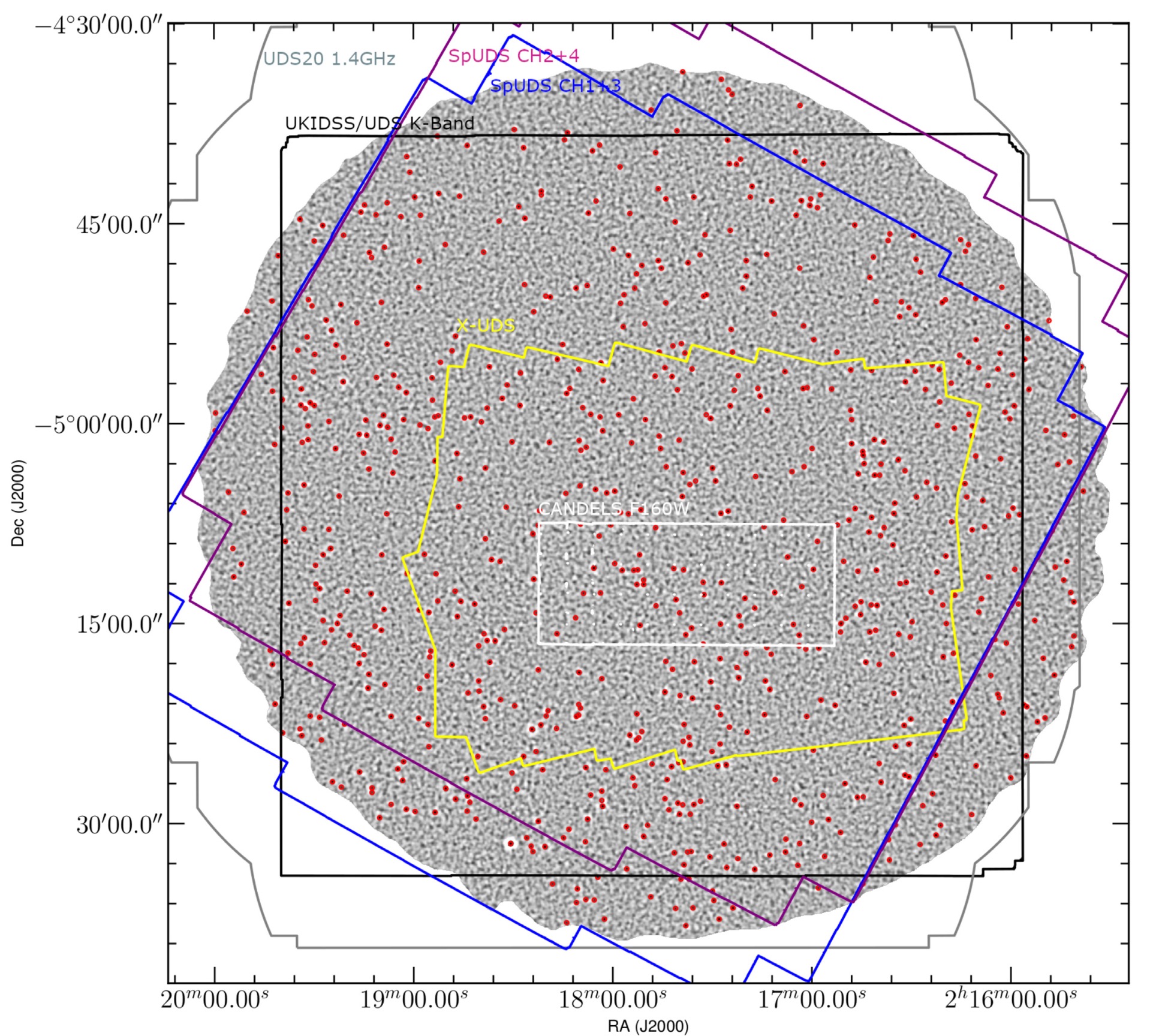
Stuart's thesis combined studies of ALMA-identified submillimetre galaxies across a range of environments and redshifts. He led a series of ALMA millimetre surveys to investigate the properties of submillimetre sources found in a SCUBA-2 survey of ten z>1 clusters, publishing the striking results on the first example: XCSJ2215 as part of his thesis. He then led the analysis and cataloguing of the ALMA follow-up of the 712 SCUBA-2 sources from the full S2CLS UDS map. This survey yielded ~7x larger sample of ALMA-identified submillimetre galaxies than our earlier ALESS survey, which was itself the largest such study at its time of publication. Stuart published the full catalogue of the sources and some of their fundamental multiwavelength properties, including the fraction which exhibit AGN activity in the X-ray and mid-infrared, as well as the precise counts of sources from this uniquely large survey.
Stuart is currently working for the UK Government.
Thesis Publications
``An ALMA survey of the SCUBA-2 Cosmology Legacy Survey UKIDSS/UDS field: Source catalogue and properties'', Stach, et al., (2019). (Link).
``An ALMA survey of the SCUBA-2 Cosmology Legacy Survey UKIDSS/UDS field: Number counts of submillimeter galaxies'', Stach, et al., (2018). (Link).
``ALMA pin-points a strong over-density of U/LIRGs in the massive cluster XCSJ2215 at z=1.46'', Stach, et al., (2017) (Link).
James Simpson (STFC, 2011-2015)
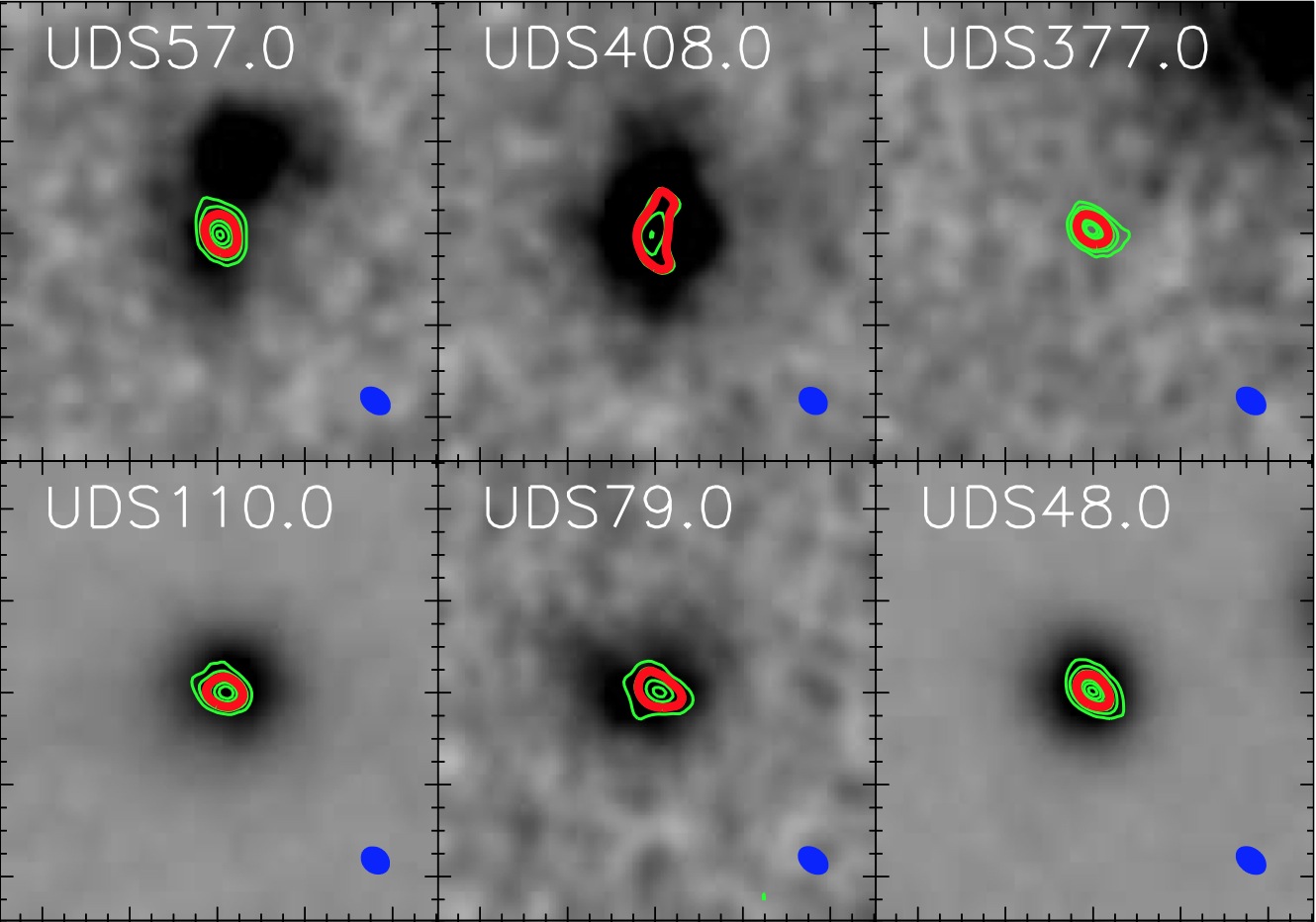
James's thesis dealt with determining and understanding the properties of submillimetre galaxies using ALMA to study samples from two surveys, with LABOCA on ECDFS and from the SCUBA-2 Cosmology Legacy Survey (S2CLS) in the UDS. His study of the ECDFS sample revised the earlier work by Julie Wardlow using the newly available submillimetre identifications of 122 LABOCA sources from an ALMA Cycle 0 project. His work on a pilot ALMA study of the S2CLS UDS region focused on a sample of bright submillimetre galaxies selected from this wide-area survey to derive the number counts of bright sources, free from the effects of confusion. He also took advantage of the high angular resolution of the delivered ALMA data to derive the sizes of the submillimetre galaxies for the first time.
James is currently working for HSBC.
Thesis Publications
``The SCUBA-2 Cosmology Legacy Survey: ALMA resolves the bright-end of the sub-mm counts'', Simpson, et al., (2015b). (Link).
``The SCUBA-2 Cosmology Legacy Survey: ALMA Resolves the Rest-frame Far-infrared Emission of Sub-millimeter Galaxies'', Simpson, et al., (2015a). (Link).
``An ALMA Survey of Submillimeter Galaxies in the Extended Chandra Deep Field South: The Redshift Distribution and Evolution of Submillimeter Galaxies'', Simpson, et al., (2014). (Link).
``The evolutionary connection between QSOs and SMGs: molecular gas in far-infrared luminous QSOs at z~2.5'', Simpson, et al., (2012). (Link).
Alice Danielson (STFC, 2009-2014)
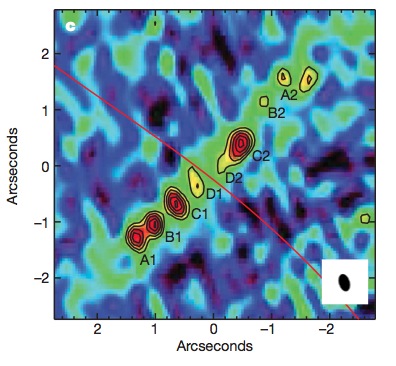
A large part of Alice's thesis involved investigating the physical processes occuring within a unique submillimetre galaxy at z=2.3. This galaxy is a typical submillimetre galaxy which happens to be gravitationally magnified by a factor of ~33x by a foreground cluster of galaxies. This magnification means that we could investigate the internal structure and properties of this galaxy at a level detail which would be otherwise impossible for unlensed examples until full-ALMA operations (and difficult even then). Alice's work has mapped the properties of the interstellar medium within this active starbursting system, showing that it contains a multi-phase ISM whose dense gas is in a similar state to that in local starbursts (even though the activity in the distant system is occuring over a larger region than seen in local systems).
Alice moved to become an outreach officer at Exeter University.
Thesis Publications
``An ALMA survey of sub-millimetre galaxies in the Extended Chandra Deep Field South: Spectroscopic redshifts'', Danielson, et al., (2017). (Link).
``13CO and C18O emission from a dense gas disc at z = 2.3: abundance variations, cosmic rays and the initial conditions for star formation'', Danielson, et al., (2013). (Link).
``The cosmic history of hot gas cooling and radio active galactic nucleus activity in massive early-type galaxies'', Danielson, et al., (2012), MNRAS, 422, 494.
``The Properties of the Inter-stellar Medium within a Star-forming Galaxy at z=2.3'', Danielson, et al., (2011). (Link).
Julie Wardlow (STFC, 2007-2011)

The focus of Julie's thesis was photometric-redshift determinations for sub/millimetre galaxies. She analysed two 0.5-degree scale sub/millimetre surveys: one centered on the z=0.51 cluster MS0451-03 using the AzTEC millimetre camera on the JCMT; the second a survey with LABOCA on APEX of the Extended Chandra Deep Field South (ECDFS). The former analysis attempted to identify obscured starbursts in the cluster, finding two possible candidates, whose star formation rates would significantly increase the total amount of on-going star formation in this apparently "dead" cluster. The latter analysis exploited the high-quality archival photometric data available for ECDFS to derive precise photometric redshifts for a large sample of submillimetre galaxies. One particularly noteworthy feature was the analysis of the redshift distribution of submillimetre galaxies without robustly identified counterparts, which showed that these systems are not at significantly higher redshifts than the identified population.
Julie is currently a Lecturer at Lancaster University.
Thesis Publications
``The LABOCA survey of the Extended Chandra Deep Field South: A photometric redshift survey of submillimetre galaxies'', Wardlow, et al., (2011). (Link).
``An AzTEC 1.1-mm Survey for ULIRGs in the field of the Galaxy Cluster MS0451.6-0305'', Wardlow, et al., (2010). (Link).
Jim Geach (PPARC, 2005-2007)
Jim's thesis dealt with investigating the interplay of the environment with the (predominantly obscured) star-formation and AGN activity within galaxies. He exploited a range of multiwavelength tools to provide more complete censuses of the obscured activity in overdense structures from z=0.4 to z=3, including near-, mid-infrared, submillimetre and radio observations. He worked on three main projects for his thesis: a multiwavelength survey of luminous obscured sources in intermediate redshift clusters; a near-infrared narrow-band survey for H-alpha emitters at z=2.23 and a multiwavelength study of the z=3.1 protocluster in SSA22. The results from these are described in the linked papers given below.
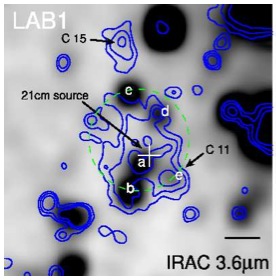
The lowest redshift part of Jim's thesis involved the analysis of panoramic MIPS 24um imaging from the Spitzer Space Telescope of two massive clusters at z~0.5. The mid-infrared imaging provides an opportunity to identify luminous, but highly obscured starbursts and AGN within the cluster - populations which are difficult to identify in other wavebands. The discovery of a significant population of dusty starbursts within clusters altered our understanding of the evolution of galaxies in high density environments, which was previously believed to simply involve the wide-spread decline of star formation in galaxies as they enter denser and denser environments.
Jim also undertook the pilot survey for the larger HiZELS project. This is a near-infrared, narrow-band search for H-alpha emitters at z=0.8-2.2 using the panoramic WFCAM imager on UKIRT. One of the goals of HiZELS is to determine a more reliable measurement of the evolution of the star formation density in the Universe using a single, well-calibrated dust-insensitive tracer of star formation: H-alpha luminosity, at all redshifts. The pilot study covered 1.5 square degrees in the UKIDSS UDS and COSMOS fields, to determine the luminosity function of H-alpha emitters at z=2.23 and so derive the integrated star formation rate at this epoch, showing significant evolution compare to similar H-alpha-derived estimates at z < 1.
The highest redshift element of Jim's thesis was a multiwavelength study of the galaxy populations with a proto-cluster at z=3.1, serendipitously discovered in the SSA22 field. He first used the SCUBA submillimetre camera to search for luminous far-infrared sources associated with a population of spatially extended Lyman-alpha halos discovered in this structure (potentially indicating the sites of large-scale outflows from young galaxies or AGN). He then used used MIPS 24um and IRAC 3.6-8um imaging from Spitzer, as well as HST data, to track down the location of the ultraluminous activity within the two largest Lyman-alpha halos and so derive the spectral energy distributions for the objects powering these very large halos.
Jim is currently a Professor at University of Hertfordshire.
Thesis Publications
``A wide-field near-infrared narrowband survey of the COSMOS field: the Cosmic star formation rate density and clustering of H-alpha emitters at z=2.23'', Geach, et al., (2007). (Link).
``Spitzer Identifications and Classifications of Submillimeter Galaxies in Giant, High-Redshift, Ly-alpha Emission Line Nebulae'', Geach, et al., (2007). (Link).
``A Panoramic Mid-Infrared Survey of Two Distant Clusters'', Geach, et al., (2006). (Link).
``A submillimetre survey of Lyman-alpha haloes in the SA22 protocluster at z=3.1'', Geach, et al., (2005). (Link).
Mark Swinbank (PPARC, 2003-2005)
Mark's main supervisor was Richard Bower, although I worked with him on several projects which went into his thesis (listed below). Mark's thesis involved spectroscopic studies of moderate- and high-redshift galaxies, employing both traditional long-slit spectrographs and the new-generation of ''3-D'' integral field unit [IFU] spectrographs (many of which have been developed and built in Durham). These IFU spectrographs provide spectral information across a 2-d patch of sky, typically a few arcseconds in extent in both dimensions, and so allow the mapping of kinematcs and spectral properties across a galaxy.
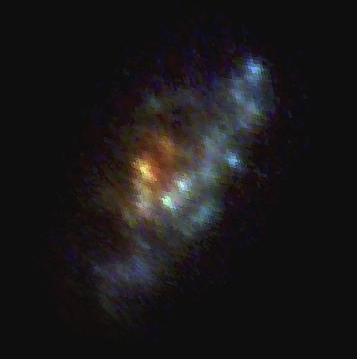
Mark's thesis exploited IFU spectrographs to map the kinematics of line-emitting gas within spiral galaxies out to z=1, to estimate the evolution of the "Tully-Fisher" [TF] scaling relation which relates a spiral galaxy's mass to its luminosity. He further boosted the sensitivity of his survey by studying spiral galaxies which appear as giant arcs, having been gravitationally lensed by foreground clusters. These lensed galaxies are both larger and brighter than they would appear in the absence of the lensing cluster - improving both the spatial resolution and signal-to-noise of Mark's IFU observations. His conclusions on the evolution of the TF relation are given in the papers listed below.
The main element of my work with Mark during his thesis were two studies of high-redshift galaxies selected on the basis of their submillimetre emission. This population in the early Universe comprises some of the most luminous galaxies which have ever existed and determing the origin and cause of these immense luminosities was a key goal of Mark's work. He used both near-infrared long-slit observations (from Keck and VLT) and near-infrared and optical IFU observations (mostly from UKIRT) to unravel the power sources and dynamics of submillimetre galaxies: showing them to be massive starbursts.
Mark is currently a Professor at Durham University.
Thesis Publications (where I am a co-author)
``Galaxies Under the Cosmic Microscope: Resolved Spectroscopy and New Constraints on the z=1 Tully Fisher Relation'', Swinbank, et al., (2006). (Link).
``The Link Between Sub-mm Galaxies and Luminous Ellipticals: Near-Infrared Integral Field Spectroscopy of SCUBA Galaxies'', Swinbank, et al., (2006). (Link).
``Optical and Near-Infrared Integral Field Spectroscopy of the SCUBA Galaxy N2-850.4'', Swinbank, et al., (2005). (Link).
``The Restframe Optical Spectra of SCUBA Galaxies'', Swinbank, et al., (2004). (Link).
``Galaxies Under the Cosmic Microscope: A GMOS Study of the Lensed Galaxy #289 in A2218'', Swinbank, et al., (2003). (Link).
Graham Smith (PPARC, 1999-2001)
Graham's thesis project was based on an HST programme to study gravitational lensing in a well-defined sample of 12 X-ray luminous clusters at a redshift of z~0.2 (equivalent to a lookback time of 3 Gyrs). This programme was a joint project between Jean-Paul Kneib, Harald Ebeling and me. The bulk of these data (8 clusters) came from our successful Cycle 8 proposal, with the remaining 4 systems coming from either clusters we had observed in earlier cycles or from the Archive. The main results from his thesis are given in the papers listed below.
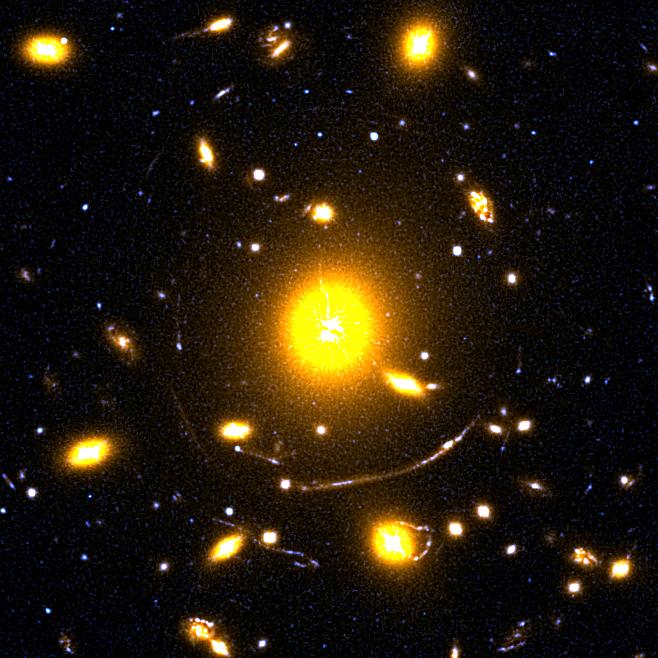
In addition to the HST observations, this sample was also the subject of an intensive multiwavelength study. This encompasses X-ray observations from XMM/Newton, panoramic optical imaging with the CFH12K camera on CFHT, deep near-infrared imaging from UFTI/UKIRT and INGRID/WHT, submillimeter mapping with the SCUBA camera on the JCMT, and a range of spectroscopic surveys covering the cluster galaxies (with LDSS2/WHT and MOS/CFHT), gravitationally lensed arcs (LRIS/Keck, GMOS/Gemini and FORS/VLT) and near-infrared spectroscopy of very red sources identified in these fields (NIRSPEC/Keck, CGS4/UKIRT and ISAAC/VLT).
Graham's focus was the construction of detailed mass models for each cluster, working from the numerous strongly-lensed features visible in the HST imaging (using a software package written by Jean-Paul) and supplemented by spectroscopic observations of the brighter arcs and arclets. These features were then analysed to map the distribution of mass on scales from 10kpc to 1Mpc within the cluster cores: providing unique information about the nature of the dominant mass component - dark matter.
In addition, these mass models can be used to investigate the properties of a range of high-redshift galaxy populations which are gravitationally amplified by the cluster cores. To this end, Graham exploited the multi-colour photometry from our CFHT/UKIRT/WHT imaging to construct a sample of very red galaxies - tracing the properties of this unusual population to much fainter magnitude limits than previously possible.
Graham's mass maps were then extended to large scales by combining them with the weak lensing signal extracted from the panoramic CFHT imaging, and the large scale mass distribution from this analysis subsequently contrasted against the results from the X-ray observations from XMM/Newton of hot gas, gravitationally confined within the cluster potentials and the dynamical analysis of the cluster galaxy population from our spectroscopic survey.
Graham is currently a Reader at Birmingham University.
Thesis Publications
``A Hubble Space Telescope Lensing Survey of X-ray Luminous Galaxy Clusters: IV. Mass, Structure and Thermodynamics of Cluster Cores at z=0.2'', Smith, et al., (2005). (Link).
``Measuring Sigma-8 with Cluster Lensing: Biases from Unrelaxed Clusters'', Smith, et al., (2003). (Link).
``An HST Lensing Survey of X-ray Luminous Clusters: III. A Multiply-imaged Extremely Red Galaxy at z=1.6'', Smith, et al. (2002). (Link).
``An HST Lensing Survey of X-ray Luminous Clusters: II. A Search for Gravitationally Lensed EROs'', Smith, et al., (2002). (Link).
``Near-infrared Spectroscopy and Hubble Space Telescope Imaging of a Dusty Starburst ERO'', Smith, et al., (2001). (Link).
``An HST Lensing Survey of X-ray Luminous Clusters: I. A383'', Smith, et al. (2001). (Link).
Kevin Pimbblet (PPARC, 1998-2000)
Kevin's thesis dealt with the properties of galaxies in a large sample of X-ray selected clusters at z~0.1 (around 1.5-2 billion years ago). This project was based on very-wide field (2×2 degree) multi-colour imaging from the 40" telescope at Las Campanas Observatory in Chile. This programme was called the LARCS project - the Las Campanas/AAT Rich Cluster Survey - and was a long-term collaborative effort by Warrick Couch, Alastair Edge, Ann Zabludoff and me. LARCS involved imaging a sample of over 20 clusters over 2-degree fields with a mosaic of CCD images, covering a total of over 70 square degrees of sky in B and R passbands. The whole sample was observed with the ROSAT X-ray telescope to provide detailed maps of the X-ray emission in these luminous systems, and a subset of the clusters were targetted for more detailed X-ray observations with XMM/Newton to provide temperature maps for the hot intracluster gas. The core results from Kevin's work on LARCS are described in the publications listed below.
The first part of Kevin's thesis involved the reduction and analysis of this immense dataset (comprising around 50Gb's of raw data). Having achieved this, he then tested the precision of his final galaxy catalogues through a comparison with the photographic survey of these regions constructed by the APM project. This comparison illustrated the advantages in terms of sensitivity and resolution of the CCD-based LARCS survey over previous photographic surveys.
Kevin's next step was to analyse the high-precision colours for galaxies in his catalogues to trace the variation in the typical colours of galaxies over a very wide range of environment - stretching from the highest density cores of his clusters, out to ~8Mpc - the point where the clusters merge into the surrounding large scale structures. This analysis was unique in terms of its field-of-view and photometric precision, a combination which is essential to trace the very small changes in galaxy colours (a few percent differences) which occur in different environments.
In addition, Kevin used his galaxy catalogues to select targets for spectroscopic follow-up with the 400-fibre 2dF multi-object spectrograph on the 3.9-m AAT in Australia. In combination with previous observations, he amassed spectra of 3-4,000 galaxies in the fields of six clusters from the survey. These were analysed to provide information on the dynamical status of these clusters, the spectral properties of their member galaxies, and most interestingly the relationship between kinematic and spectral characteristics of different galaxy populations: actively star-forming, recently star-forming and passive.
Kevin is currently a Senior Lecturer at Hull University.
Thesis Publications
``The Las Campanas/AAT Rich Cluster Survey - III. Spectroscopic Studies of X-ray Bright Clusters at z~0.1'', Pimbblet, et al., (2006). (Link).
``The Las Campanas/AAT Rich Cluster Survey: II. The Environmental Dependance of Galaxy Colours in Clusters at z~0.1'', Pimbblet, et al. (2002). (Link).
``The Las Campanas/AAT Rich Cluster Survey: I. Precision and Reliability of the Photometric Catalogue'', Pimbblet, et al. (2001). (Link).